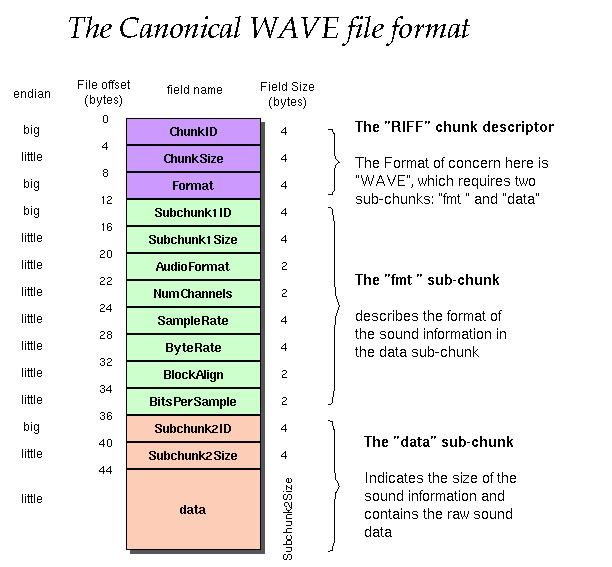Introduction
The WAVE file format is a subset of Microsoft's RIFF specification for the storage of multimedia files. A RIFF file starts out with a file header followed by a sequence of data chunks. A WAVE file is often just a RIFF file with a single "WAVE" chunk which consists of two sub-chunks -- a "fmt" chunk specifying the data format and a "data" chunk containing the actual sample data. Call this form the "Canonical form".

The main idea is to create only one header for all WAV files that you want to concatenate and then write data of each file in a single file.

Wave file headers follow the standard RIFF file format structure. The first 8 bytes in the file are the standard RIFF chunk header which have a chunk ID of "RIFF" and a chunk size equal to the file size minus the 8 bytes used by the header.
So we need to know the total length of all files to define ChunkSize and read NumChannels, SampleRate and BitsPerSample.
private void WaveHeaderIN(string spath)
{
FileStream fs = new FileStream(spath, FileMode.Open, FileAccess.Read);
BinaryReader br = new BinaryReader(fs);
length = (int)fs.Length - 8;
fs.Position = 22;
channels = br.ReadInt16();
fs.Position = 24;
samplerate = br.ReadInt32();
fs.Position = 34;
BitsPerSample = br.ReadInt16();
DataLength = (int)fs.Length - 44;
br.Close ();
fs.Close();
}
As we know channels are stored in the WAV header in byte number 22, we move the current position of the file to this location and the size of it is 2 bytes so we use br.ReadInt16() to read only 2 bytes and so on....
Construct the Header of Merged File
private void WaveHeaderOUT(string sPath)
{
FileStream fs = new FileStream(sPath, FileMode.Create, FileAccess.Write );
BinaryWriter bw = new BinaryWriter(fs);
bw.Write(new char[4] { 'R', 'I', 'F', 'F' });
bw.Write(length);
bw.Write(new char[8] {'W','A','V','E','f','m','t',' '});
bw.Write((int)16);
bw.Write((short)1);
bw.Write(channels);
bw.Write(samplerate );
bw.Write((int)(samplerate * ((BitsPerSample * channels) / 8)));
bw.Write((short )((BitsPerSample * channels) / 8));
bw.Write(BitsPerSample);
bw.Write(new char[4] {'d','a','t','a'});
bw.Write(DataLength);
bw.Close();
fs.Close();
}
We must be careful when writing the header. If there is any small mistake, the merged file doesn't work, so we write "RIFF" as an array of char, not as string and use int type for storing 4 bytes and short type for storing 2 bytes.
Write Data of all Files in the Merged File
public void Merge(string[] files, string outfile)
{
WaveIO wa_IN = new WaveIO();
WaveIO wa_out = new WaveIO();
wa_out.DataLength = 0;
wa_out.length = 0;
foreach (string path in files)
{
wa_IN.WaveHeaderIN(@path);
wa_out.DataLength += wa_IN.DataLength;
wa_out.length += wa_IN.length;
}
wa_out.BitsPerSample = wa_IN.BitsPerSample;
wa_out.channels = wa_IN.channels;
wa_out.samplerate = wa_IN.samplerate;
wa_out.WaveHeaderOUT(@outfile);
foreach (string path in files)
{
FileStream fs = new FileStream(@path, FileMode.Open, FileAccess.Read);
byte[] arrfile = new byte[fs.Length - 44];
fs.Position = 44;
fs.Read(arrfile, 0, arrfile.Length);
fs.Close();
FileStream fo =
new FileStream(@outfile, FileMode.Append, FileAccess.Write);
BinaryWriter bw = new BinaryWriter(fo);
bw.Write(arrfile);
bw.Close();
fo.Close();
}
}
First we need to calculate the total length and data length of all files and then specify the channels, SampleRate and BitsPerSample of the output file.The last thing is to start reading data that is stored after byte number 44 and append it to the merged file.
All we need to do is call the Merge method and specify the input files and output file.
string[] files = new string[2] { @"C:\WINDOWS\Media\Windows XP Startup.wav",
@"C:\WINDOWS\Media\Windows XP Shutdown.wav" };
WaveIO wa = new WaveIO();
wa.Merge(files,@"c:\oou.wav");
Play the Merged File
Visual Studio 2005 provides a new class to play sound. Therefore, we don't need an API or anything else.
FileStream fs = new FileStream(@"c:\oou.wav", FileMode.Open,FileAccess.Read);
System.Media.SoundPlayer sp = new System.Media.SoundPlayer(fs);
sp.Play();
fs.Close();
References
